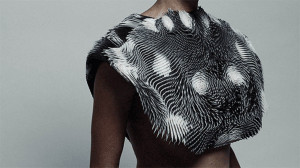
An interactive, 3D-printed wearable has been developed that can detect the gaze of another person and respond accordingly with life-like behavior. The developers of “Caress of the Gaze” say it opens the possibility of a radical new approach to interactive clothing, inspired by nature and the behavior of human skin. Our skin expands, contracts and changes its shape based on stimuli including temperature, moisture and even feelings such as fear, excitement and anger.
The project poses the question, “What if our clothing could behave as an artificial skin capable of changing its shape and operating as an interface with the world?”
Designed by Behnaz Farahi, the project was developed in San Francisco as part the Artist Residency at Pier9, Autodesk and sponsored by the Madworkshop Foundation.
The project demonstrates three main developments:
1. How advanced 3D-printing technologies might contribute to fashion, specifically the fabrication of composite materials with varying flexibilities, densities, and material properties, deposited in a single print run. Inspired by the flexible behavior of the skin itself, this garment exhibits different behaviors in various parts of the body ranging from stiff to soft.
2. It explores the potential of an actuation system, assembled something like a muscle system, using Shape Memory Alloy (SMA) actuators that inform the motion of the skin.
3. It investigates how clothing could interact with other people using computer vision technologies. An image-sensing technology camera, capable of detecting gender, age and orientation of the gaze, is used to communicate with a microcontroller that reads and controls nodes in the garment.
According to the designer’s website, the project addresses the emerging field of shape-changing structures and interactive systems, bridging fashion, art, technology and design. It does this by implementing design/motion principles inspired by natural systems, to rethink the relationship between our bodies and the surrounding environment.
An article in www.wired.com, January 1, 2016, provides more details about Farahi’s method. “Like a fish’s scales, the garment contains rigid structures and pliant ones It’s difficult to incorporate both in a 3-D printed object, but Farahi says she overcame this problem by printing along a gradient, with materials of varying flexibility and density. “Like the skin of an animal, the garment moves, not atop muscles, but an actuation system assembled from shape-memory alloy. And, like goose bumps, the garment responds autonomously, controlled by a front-mounted camera that detects the orientation of an onlooker’s gaze.”
 TEXTILES.ORG
TEXTILES.ORG


